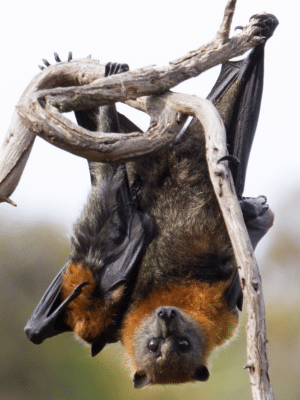It’s birthing season for Grey-Headed and Black flying foxes, which means we are currently welcoming in our next generation of keystone pollinators, flying fox pups, to our main flying fox camp, Kooloonbung Creek Reserve.
While flying foxes often get a bad rap for their noisy and somewhat smelly presence, they are in fact vital to our ecosystem, pollinating native plants and dispersing seeds. Without them, our koalas would be without homes and food, as would many important members of our local environment.
Grey-Headed flying foxes are also listed as vulnerable to extinction, making breeding and birthing seasons even more important when it comes to protection of our precious natural environment.
It’s important, therefore, that as a community we gain a better understanding and appreciation of these species and the role we can play during birthing season (and at all times) to minimise disruption of their roosts and ensure their protection and safety so that today’s pups become tomorrow’s heroes of our ecosystem.
About flying fox pups

Grey-Headed and Black flying foxes give birth throughout spring and summer. Born blind and unable to regulate their own temperature, pups depend entirely on their mothers for the first few months of life for food, warmth and protection.
As mammals, they will nurse from their mothers for the first 4-6 months, at which point they will begin eating more and more solid food, such as fruit and nectar.
Carried on their mothers’ bellies during nightly foraging, they gradually learn to fly and forage independently as they grow, although they remain vulnerable for many more months to come, being more susceptible to predators and diseases.
How we can support flying fox mums and pups
As responsible members of our shared natural environment, it is important (and, in fact, legislatively required) that we respect the habitat and well-being of flying foxes and their pups, particularly at our main camp, Kooloonbung Creek Reserve.
We are privileged to have a beautiful boardwalk to enjoy the natural surroundings Kooloonbung Creek reserve provides. While there is no need to avoid these walks during birthing season, we do ask our community to be extra conscious of minimising disturbance. As always, it is important to refrain from loud noises or other disruptions that may stress flying foxes, causing them to take flight during the day, which places them under unnecessary dangers from predators and at risk of dehydration and heat exhaustion.
During this season, mother flying-foxes tend to forage closer to their roost than normal to stay close to their pups. This means they are flying in more urban areas than they might, which puts them in greater risk of being stranded, entangled or injured via powerlines, fencing, or netting.
If you choose to place netting in your gardens, ensure it is small enough mesh so as to not trap animals. As a guide, netting should be taut, secured to the ground, and the mesh diameter needs to be small enough (2mm is good) that you can’t poke a finger through the holes.
If you see a sick or injured flying fox, do not attempt to handle it yourself. Instead, report the sighting to FAWNA rescue line on 02 6581 4141.
Your knowledge and support play a vital role in ensuring a thriving future for flying fox pups and the biodiversity they help sustain. Together, as a community, let's celebrate the wonders of nature and take responsibility for protecting our environment, preserving these remarkable animals for future generations.
To learn more about these remarkable creatures and our local Kooloonbung Creek Camp Management Plan, please visit the Port Macquarie-Hastings Council website at pmhc.nsw.gov.au/flying-foxes.





